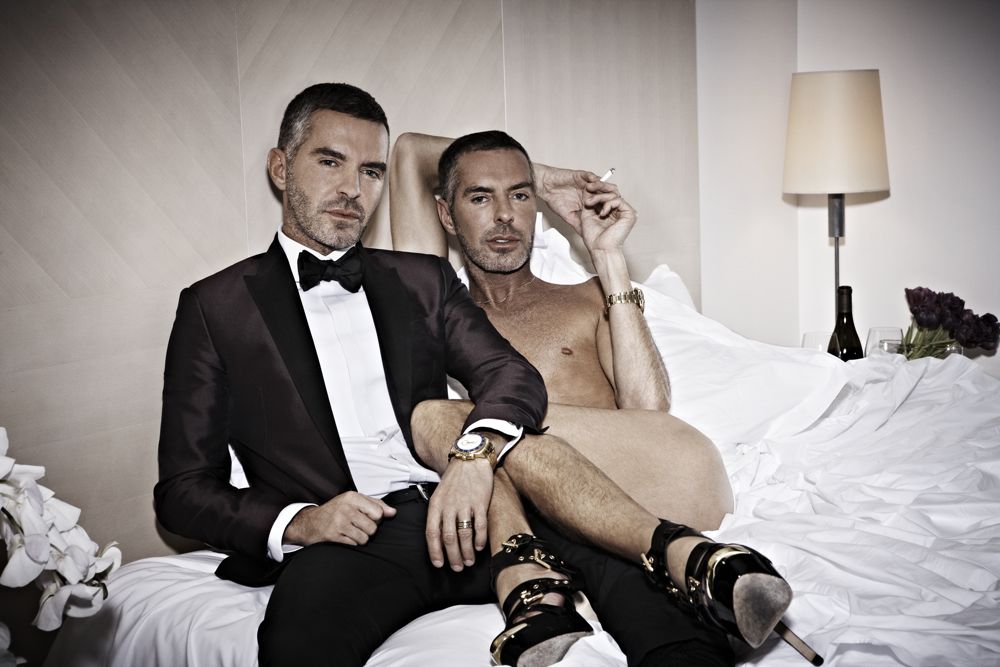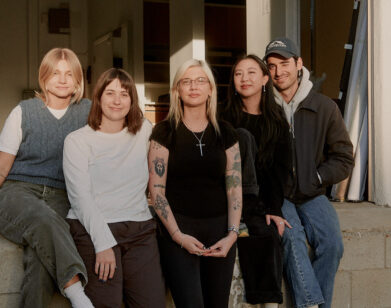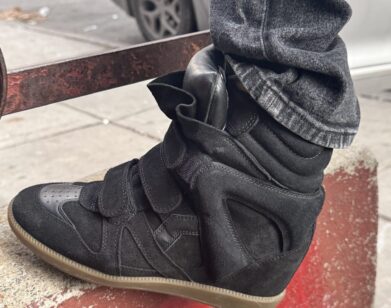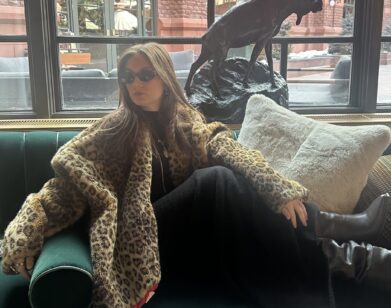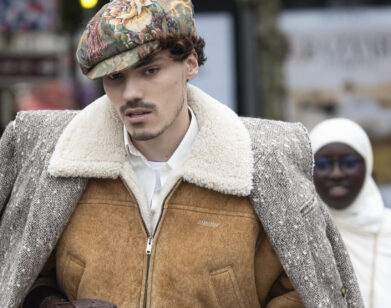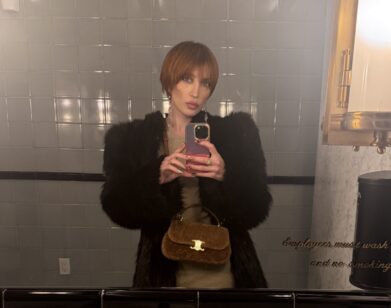Dan & Dean Caten
IT’S ABOUT OUR STORY. IT’S ABOUT BEING BRAVE AND TAKING RISKS. WE ARE NOT ONE OF THOSE COMPANIES WHO THINK ONLY ‘CORPORATE.’ Dean Caten
Designers often go back to their roots for inspiration. But the roots aspect of their own formative past that designer twin brothers Dan and Dean Caten explored for their Spring 2013 campaign for Dsquared2 is a little more personal—and far more glamorous—than the usual wistful backward glance. Dan and Dean, now 48, have been making scenes since their youth in the Toronto suburb of Willowdale. During their dress-up period in the early ’90s, floating around the French and Italian Rivieras, the Catens regularly transformed into fantastic femme fatales of nightlife, blending their innate taste and knowledge of fashion with their love of a good time. “We were designers in Canada, but at that time, we were trying to become designers in Italy,” Dan remembers. “It wasn’t as easy as we thought. We weren’t working as much as we wanted, so dressing up was our best way to earn money and be fabulous and have a creative release.” In the process, the brothers created a roster of twinning female characters, big on makeup, wigs, and over-the-top apparel, that would serve as personalities or “images” at parties and clubs.
While surviving on their glam self-transformations lasted only about three years, Dean and Dan returned to those subversive glamazonian days this spring, starring in their own campaign in and out of drag; they even strutted out in their ensembles, wigs, and heels for a special one-and-a-half-minute film called Behind the Mirror, shot by Mert Alas and Marcus Piggott. The men may have grown up—and built a brand empire—but it’s clear they still have the rare ability to make a party out of a killer wardrobe, a little foundation, and some gender-bending dance moves.
JASMINE SERRURIER SFORNI: How did the idea for Behind the Mirror first come about?
DEAN CATEN: Twenty years ago, we used to play around at being models. Now for the Spring collection, we are looking back to the ’90s, and we asked ourselves what we were doing in those years and realized we were pretending to be people we weren’t. We saw a story and went for it. Our motto has always been: “Free to be and do as we choose.”
SERRURIER SFORNI: What kind of people were you pretending to be in the early ’90s?
DAN CATEN: We were being paid to go to clubs so there would be something exciting for the other guests to look at. We would dance and get up on stage and make the night interesting. Our “images” were always “twins.” We had different names for different characters. There was Lisa and Leslie—they were the most slutty ones. And Delta and Dakota—they were redheads and the most chic. And Amber and Ashley . . . We always made our costumes from scratch. That was the fun part. We had all week to make our outfits for Saturday night. We’d sit there behind the sewing machine, à la Paris Is Burning [1990], waiting for the next ball.
SERRURIER SFORNI: So the campaign—and, in particular, the Behind the Mirror video—draws from a personal place, your own self-developed understanding of fashion and glamour.
DEAN: It’s about our story. It’s about being brave and taking risks. We are not one of those companies who think only “corporate”—our bottom line is not about making money—so this video was a chance to share our journey and creativity with the people who love what we do. And, of course, have a good time while we do it!
DAN: The video really is a snapshot of our past. As kids, both at school and at home in Willowdale, Dean and I were always seen as different . . . and strange. We didn’t have many friends. We were teased and picked on. So for me, this video is important, as it inadvertently speaks about being different—being different and being okay with this difference.
SERRURIER SFORNI: I imagine one of the great things about being a twin is that you aren’t all alone even if you feel excluded by other kids.
DAN: I think the twin thing saved me. Being part of a pair helps because you know you have your brother and he has you, so you don’t really care if no one likes you. You have another person to create your own little world with. And that’s how we discovered fashion, where we felt we belonged, were understood and appreciated. Once we found our way, we were determined to do our best; when we made costumes, we wanted not just to be good, but fantastic. It reminds me of that line in Paris Is Burning: “If you shoot an arrow in the sky and it goes real high, hooray for you!”
SERRURIER SFORNI: The icy blonds in the ad campaign—which, of course, are you two—are very much glamazons. Was that the inspiration?
DAN: The word glamazon came about with the ’90s supermodel. For the campaign and the video, we took this idea a bit further, introducing a Hitchcock mood, so it’s ’90s-meets-Hitchcock-meets-film-noir-meets-Grace Kelly.
DEAN: Not that I think I look like Grace Kelly!
SERRURIER SFORNI: How did the physical transformation go for you? Did it take hours in hair and makeup?
DEAN: It’s exciting and intriguing to have that process of makeup, clothes, hair, and then you look in the mirror and don’t even realize it’s you. The beauty is that you are somebody else that nobody knows, so you are free to be whoever you want to be. This experience made us realize that we are not the same girls we were 20 years ago. I was shocked when I saw myself again in full makeup. Now I look as if I have really arrived. I have lost that naive, girly charisma; I’m now more confident, more sophisticated, and you can see that in the video. This campaign reminded us of our journey.
DAN: It’s about being a man, being a woman, being who you need to be—what feels right for you and what’s best for you. Some people look in the mirror and they see themselves. Some people look in the mirror and they see a monster. Some people look in the mirror and are not sure what they see. It’s about looking deeper: “Who am I? Who do I want to be?”
SERRURIER SFORNI: Did you feel more was at stake because you weren’t dressing up just for yourselves or for parties and clubs; you were doing a film for your own brand in front of Mert and Marcus?
DEAN: Yes, it’s one thing slipping on a pair of high heels and dancing around your apartment in your underwear pretending to be Madonna. It’s another thing being on set doing the same sort of thing in front of others with no alcohol to relax you. You arrive as a man, owner of a fashion brand, paying the bills, and then you are a woman dancing in front of a bunch of guys who are probably thinking you’re crazy. Let’s just say I would have preferred to stand in a bus shelter in my underwear than become this other person in front of a bunch of people I didn’t know. I mean, nobody said, “Hey, you look hot!” It was all very serious and there were no comments, no reaction, nothing. No reaction is the worst. I was terrified and really wasn’t comfortable until the last scene. It was harder than I thought.
DAN: The makeup was crazy. First we got our faces massaged so that they became “elasticized.” Then our skin was pulled back. The key thing was to get the skin on the face tight and pulled: our cheeks, forehead, and necks were all tied and glued so that all the lines were removed. Charlotte Tilbury did an amazing job. The full makeup session took about two and a half hours. The wigs we used were made of sheer transparent tulle at the front, so that the hairline looked as if it came straight out of our heads, leaving a natural-looking female hairline. Oribe, who worked on the original supers, like Linda Evangelista, in the ’90s, created the hairstyles, so it was super to have him on board, too.
SERRURIER SFORNI: How did you get the idea of being mirrors for each other in the video—and all of the mirrors that run throughout? You were playing off being twins in so many ways.
DAN: The concept of using a mirror in the video actually came from the idea of creating an illusion—you reach in and the twin brother is on the other side. Yet it’s not just about a reflection and creating an illusion. We want this video to be something deeper: What is beyond the person being represented? What is in the past? What is the unknown?
DEAN: There are lots of messages wrapped up in this campaign: Don’t be afraid to do what you want to do. It’s about being irreverent. We’re designers, not politicians, and therefore we can have some fun! It’s about experimenting—it’s a creative release, and we want to be groundbreakers. Plus, it’s a reminder of where we came from and that it doesn’t matter where you started; it’s all about where you want to go. And then there’s the taboo aspect of the video- men dressed as women. As soon as everyone said, “Don’t do it,” we wanted to do it, and take that risk.
JASMINE SERRURIER SFORNI IS A MILAN-BASED FREELANCE JOURNALIST AND BLOGGER (JASMOLOGY.COM).

